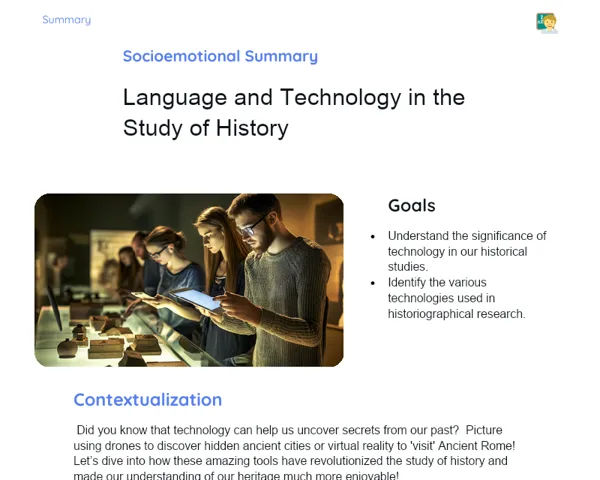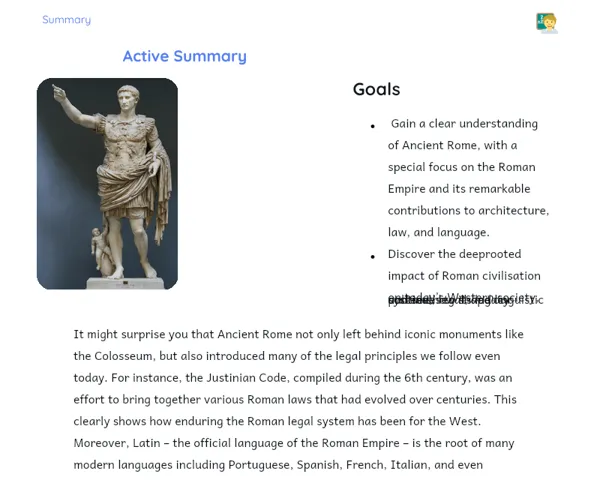Summary Tradisional | Islam: Birth and Expansion: Review
Contextualization
Islam, one of the major world religions, began in the 7th century on the Arabian Peninsula. Founded by Prophet Muhammad, who claimed to have received divine messages from the angel Gabriel, Islam spread rapidly across the Middle East, North Africa, and parts of Europe and Asia. This religion not only affected the cultures and communities of these regions profoundly, but it also left a significant mark on global history, shaping politics, economics, and the arts during the Middle Ages and later. Understanding the inception and growth of Islam is key to appreciating the cultural, political, and religious dynamics that have influenced the modern world. Furthermore, during the Middle Ages, Islam was at the forefront of advancements in science, medicine, and philosophy, becoming a vital hub of knowledge and education. The Islamic universities were venues where renowned thinkers like Avicenna and Averroes made significant contributions to the global body of knowledge.
To Remember!
The Origin of Islam
Islam emerged in the 7th century in the Arabian Peninsula, a region inhabited by nomadic tribes and trading towns. Prophet Muhammad, born in Mecca in 570 CE, is recognized as the founder of Islam. He started receiving divine revelations from the angel Gabriel in 610 CE, which were compiled into the Quran, the holy scripture of Muslims. Initially, these messages faced resistance from local tribes as they challenged existing religious and social customs. Muhammad and his followers underwent persecution in Mecca, prompting their migration to Medina in 622 CE, an event referred to as the Hijra, which marks the start of the Islamic calendar. In Medina, Muhammad established an Islamic community and began the expansion of the new faith. He took on roles not only as a spiritual leader but also as a political and military figure, bringing together various Arab tribes under the banner of Islam. After Muhammad's passing in 632 CE, his successors, known as the caliphs, continued to propagate Islam and secure its status as a religious and political entity in the region.
-
Emergence of Islam in the 7th century in the Arabian Peninsula.
-
Prophet Muhammad receiving divine revelations.
-
Compilation of the revelations into the Quran.
-
Hijra (migration to Medina) in 622 CE.
The Five Pillars of Islam
The Five Pillars of Islam form the core of Muslim faith and practice. The first pillar, Shahada, is the testimony of faith, declaring that there is no god but Allah, and Muhammad is His messenger. This principle is crucial to Muslim identity. The second pillar, Salat, involves performing five daily prayers while facing Mecca, carried out at specific times, fostering a continual connection with God. The third pillar, Zakat, emphasizes the importance of charitable giving, encouraging Muslims to support the less fortunate, which promotes social justice and community well-being. The fourth pillar, Sawm, pertains to fasting during the holy month of Ramadan, a time dedicated to spiritual introspection, discipline, and purification. The fifth pillar, Hajj, mandates that every Muslim should undertake a pilgrimage to Mecca at least once in their lifetime if they are able to. This pilgrimage symbolizes the unity of the Muslim community and submission to God.
-
Shahada: Declaration of faith.
-
Salat: Five daily prayers.
-
Zakat: Mandatory charity.
-
Sawm: Fasting during Ramadan.
-
Hajj: Pilgrimage to Mecca.
Islamic Expansion
Following Muhammad's death, the expansion of Islam continued under the caliphs' leadership. Abu Bakr, the first caliph, successfully unified the Arabian Peninsula under Islam. His successors, the caliphs Omar, Uthman, and Ali, greatly widened Islamic reach through military campaigns. Under Omar's caliphate, Islam spread beyond the Arabian Peninsula, conquering areas like Syria, Egypt, and parts of the Sasanian Empire. The Umayyad dynasty, which held power from 661 to 750 CE, further expanded Islamic influence into North Africa, the Iberian Peninsula, and parts of Central Asia. In the ensuing Abbasid dynasty, which took over from the Umayyads, the capital was moved to Baghdad, igniting a golden age of cultural and scientific innovation. This period saw not just territorial expansion but also established Baghdad as a center for learning. The spread of Islam was driven by military conquests, commerce, and missionary efforts, leaving a lasting impact on governance, science, art, and philosophy in the regions affected.
-
Abu Bakr's unification of the Arabian Peninsula.
-
Territorial expansion under caliphs Omar, Uthman, and Ali.
-
Growth under the Umayyad dynasty to North Africa and the Iberian Peninsula.
-
Cultural and scientific advancements during the Abbasid dynasty.
Formation of Islamic Caliphates
Islamic caliphates emerged as the initial systems of government established after Muhammad's demise. The first caliphate, known as the Orthodox Caliphate, was led by the first four caliphs: Abu Bakr, Omar, Uthman, and Ali. This era witnessed rapid expansion of Islam, consolidating both administrative and military structures of the nascent empire. The Umayyad Caliphate, which followed, had its capital in Damascus and presided from 661 to 750 CE, during which time the empire reached its peak territorial extent. They centralized administration to manage their vast conquests effectively. After the Umayyads, the Abbasid dynasty gained power and established Baghdad as the new capital. The Abbasid Caliphate is renowned for facilitating significant cultural, scientific, and economic progress. Baghdad became a melting pot of scholarship and cultural interchange, with intellectuals from various regions contributing to the global growth of knowledge. Islamic caliphates substantially influenced the political and social frameworks of the areas they governed, characterized by centralized administration, advocacy for justice, and the integration of diverse cultures.
-
Orthodox Caliphate: Early consolidation and growth.
-
Umayyad Caliphate: Capital in Damascus while at its territorial peak.
-
Abbasid Caliphate: Cultural renaissance in Baghdad.
-
Influence on the political and social structure of the regions.
Cultural and Scientific Contributions
During the Islamic Golden Age, coinciding with the Abbasid Caliphate, the Islamic world became a hub of creativity and scholarship. Baghdad, the heart of the Abbasid empire, housed the House of Wisdom, an institution focused on translating and preserving classical texts and conducting research across various fields. Notable contributors like Avicenna left an indelible mark on medicine with works like 'The Book of Healing', which shaped medical practices in both the Islamic world and Europe. Averroes, another influential figure, is celebrated for his commentaries on Aristotle, which revitalized Greek philosophy in medieval Europe. Additionally, Islamic mathematicians excelled in algebra, trigonometry, and geometry. Astronomy thrived too, with scholars such as Al-Battani making accurate observations and formulating theories that impacted both Islamic thought and European learning. The contributions from the Islamic civilization weren't confined to the sciences; the realm of Islamic art, literature, and architecture also made a profound impact, characterized by Arabic calligraphy, intricate mosaics, and the construction of grand mosques.
-
Islamic Golden Age and the House of Wisdom in Baghdad.
-
Avicenna's medical contributions.
-
Averroes' role in reviving Greek philosophy in Europe.
-
Advancements in mathematics and astronomy.
-
Long-lasting influence on art, literature, and architecture.
Key Terms
-
Islam: Monotheistic faith founded by Prophet Muhammad in the 7th century.
-
Prophet Muhammad: The founder of Islam, who received divine revelations from angel Gabriel.
-
Quran: The holy scripture of Islam, containing the revelations given to Muhammad.
-
Hijra: The migration of Muhammad and his followers from Mecca to Medina in 622 CE.
-
Five Pillars of Islam: Core foundations of Islamic beliefs and practices (Shahada, Salat, Zakat, Sawm, Hajj).
-
Caliphate: Islamic governance led by a caliph, who is the successor of Muhammad.
-
Umayyad Dynasty: The first significant Islamic dynasty ruling from 661 to 750 CE.
-
Abbasid Dynasty: The second major Islamic dynasty ruling from 750 to 1258 CE.
-
Islamic Golden Age: A period marked by cultural and scientific flourishing during the Abbasid Caliphate.
-
Avicenna: An Islamic physician and philosopher, famed for 'The Book of Healing.'
-
Averroes: An Islamic philosopher known for his interpretations of Aristotle.
Important Conclusions
Studying the birth and expansion of Islam is critical to understanding the cultural, political, and social transformations that shaped the Middle Ages. The origins of Islam, beginning with Prophet Muhammad's divine revelations, led to a faith that swiftly spread beyond the Arabian Peninsula, impacting numerous regions globally. Delving into the Five Pillars of Islam clarifies the practices and beliefs that guide the lives of devout Muslims. The territorial growth of Islam under the Umayyad and Abbasid caliphates not only solidified political dominance but also initiated a period of cultural and scientific brilliance. Contributions from scholars like Avicenna and Averroes highlight the significance of knowledge exchange among various civilizations. Moreover, the establishment of caliphates laid down political and administrative frameworks that permanently influenced the regions under their authority. Comprehending these dynamics is vital for appreciating the complexities of cultural and religious interactions throughout history. By learning about Islam, its pillars, expansion, and scientific advancements, we can foster an appreciation for cultural diversity and recognize the need for mutual respect among societies. We encourage students to delve deeper into this topic to enrich their understanding of the rich tapestry of Islam’s history.
Study Tips
-
Review the key points from this summary and take detailed notes on topics that pique your interest.
-
Research historical figures like Avicenna and Averroes to learn about their contributions to science and philosophy.
-
Use additional resources such as documentaries, books, and academic articles to deepen your knowledge of Islam's expansion and influence during the Middle Ages.



